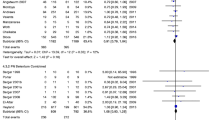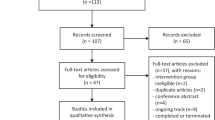Zusammenfassung
Nach den bisherigen Studien scheint in der Sepsis und im septischen Schock, bei Reperfusion oder nach einer Reanimation ein Mangel an Selen und damit sekundär an wichtigen antioxidativen Mechanismen zu bestehen. Eine Selensubstitution ist daher als ein pathophysiologisch begründeter Ansatz in Studien überprüft worden, die nicht eindeutige Ergebnisse geliefert haben. Nach den neuesten Studien bei Patienten mit schweren Infektionen scheint die Substitution von Selen in pharmakologischen Dosierungen keinen Einfluss auf das Überleben der Patienten zu haben. Allerdings wurden in den Studien unterschiedliche Therapieregimes verwendet, die möglicherweise das Ergebnis beeinflusst haben. Aktuell kann die Substitution oder Therapie mit hoch dosiertem Selen nicht als eine Maßnahme empfohlen werden, die das Überleben von Patienten mit schweren Infektionen verbessert. Nebenwirkungen wurden in sämtlichen Studien nicht beobachtet.
Access this chapter
Tax calculation will be finalised at checkout
Purchases are for personal use only
Similar content being viewed by others
Literatur
Andrews PJ, Avenell A, Noble DW, Campbell MK, Croal BL, Simpson WG, Vale LD, Battison CG, Jenkinson DJ, Cook JA and the SIGNET (Scottish Intensive care Glutamine or seleNium Evaluative Trial) Trials Group (2011) Randomised trial of glutamine, selenium, or both, to supplement parenteral nutrition for critically ill patients. BMJ 342: d1542
Angstwurm MW, Schottdorf J, Schopohl J, Gaertner R (1999) Selenium replacement in patients with severe systemic inflammatory response syndrome improves clinical outcome. Crit Care Med 27 (9): 1807–1813
Angstwurm MW, Engelmann L, Zimmermann T, Lehmann C, Spies CH, Abel P, Strauss R, Meier-Hellmann A, Insel R, Radke J, Schüttler J, Gärtner R (2007) Selenium in Intensive Care (SIC): results of a prospective randomized, placebo-controlled, multiple-center study in patients with severe systemic inflammatory response syndrome, sepsis, and septic shock. Crit Care Med 35 (1): 118–126 [Bei der SIC-Studie handelt es sich um eine doppelt-blinde und randomisierte Studie mit einer größeren Fallzahl zur Substitution von Na-Selenit bei Patienten mit SIRS, Sepsis und septischem Schock. Die Analyse aller Daten ergab keinen signifikanten Benefit in Bezug auf die Mortalität der Patienten. Lediglich in Subgruppen fanden sich Unterschiede. Unter anderem profitierten nur männliche Patienten.] ←
Beck MA. Nelson HK, Shi Q, Van Dael P, Schiffrin EJ, Blum S, Barclay D, Levander OA (2001) Selenium deficiency increases the pathology of an influenza virus infection FASEB J. 15(8): 1481–1483
Busch HJ (2009) Welchen Nutzen hat die Selensubstitution in der Post-Reanimationsphase? Dtsch Med Wochenschr 134 Suppl 11: S419–21
Dellinger RP, Levy MM, Rhodes A et al. (2013) Surviving Sepsis Campaign: International guidelines for management of severe sepsis and septic shock, 2012. Intensive Care Med 39:165–228 (siehe auch Serviceteil S 379)
Forceville X, Vitoux D, Gauzit R, Combes A, Lahilaire P, Chappuis P (1998) Selenium, systemic immune response syndrome, sepsis, and outcome in critically ill patients. Crit Care Med 26 (9): 1536–1544
Forceville X, Laviolle B, Annane D, Vitoux D, Bleichner G, Korach JM, Cantais E, Georges H, Soubirou JL, Combes A, Bellissant E (2007) Effects of high doses of selenium, as sodium selenite, in septic shock: a placebo-controlled, randomized, double- blind, phase II study. Crit Care 11 (4): R73 [Diese Studie war nicht angelegt, einen Überlebensvorteil zu demonstrieren. Es wurde die Toxizität von Na-Selenit in sehr hohen Dosen untersucht, ohne dass relevante Unterschiede in Bezug auf sekundäre Organversagen gefunden wurden.] ←
Forceville X, Mostert V, Pierantoni A, Vitoux D, Le Toumelin P, Plouvier E, Dehoux M, Thuillier F, Combes A (2009) Selenoprotein P, rather than glutathione peroxidase, as a potential marker of septic shock and related syndromes. Eur Surg Res 43 (4): 338–347
Heyland DK, Dhaliwal R, Suchner U, Berger MM (2005) Antioxidant nutrients: a systematic review of trace elements and vitamins in the critically ill patient. Intensive Care Med 31 (3): 327–337
Heyland D, Muscedere J, Wischmeyer PE, Cook D, Jones G, Albert M, Elke G, Berger MM, Day AG; Canadian Critical Care Trials Group (2013) A randomized trial of glutamine and antioxidants in critically ill patients. N Engl J Med 368: 1489–1497 [In dieser Studie wurde eine enterale Sondennahrung mit einer Supplementierung von verschiedenen Elementen untersucht. Dieses Supplement enthielt verschiedene pro- und antientzündliche Komponenten, es wurde keine Bolus-Applikation gewählt. Zudem waren die Patienten nicht schwer erkrankt. Die Supplementierung hatte keinen Einfluss auf das Überleben der Patienten.] ←
Heyland DK, Elke G, Cook D, Berger MM, Wischmeyer PE, Albert M, Muscedere J, Jones G, Day AG; on behalf of the Canadian Critical Care Trials Group (2014) Glutamine and antioxidants in the critically ill patient: a post hoc analysis of a large-scale randomized trial. JPEN J Parenter Enteral Nutr 39(4):401–409
Kryukov GV (2003) Characterization of mammalian selenoproteomes. Science 300: 1439–1443
Manzanares W, Biestro A, Torre MH, Galusso F, Facchin G, Hardy G (2011) High-dose selenium reduces ventilator-associated pneumonia and illness severity in critically ill patients with systemic inflammation. Intensive Care Med 37 (7): 1120–1127
Mishra V, Baines M, Perry SE, McLaughlin PJ, Carson J, Wenstone R, Shenkin A (2007) Effect of selenium supplementation on biochemical markers and outcome in critically ill patients. Clin Nutr 26 (1): 41–50
Reisinger J, Höllinger K, Lang W, Steiner C, Winter T, Winter A, Mori M, Lindorfer A, Kiblböck D, Siostrzonek P (2009) Does early administration of selenium improve neurological outcome after cardiac arrest? Am J Emerg Med 27 (2): 176–181
Sakr Y, Reinhart K, Bloos F, Marx G, Russwurm S, Bauer M, Brunkhorst F (2007) Time course and relationship between plasma selenium concentrations, systemic inflammatory response, sepsis, and multiorgan failure. Br J Anaesth 98 (6): 775–784
Sakr Y, Maia VP, Santos C, Stracke J, Zeidan M, Bayer O, Reinhart K (2014) Adjuvant selenium supplementation in the form of sodium selenite in postoperative critically ill patients with severe sepsis. Crit Care 18: R68
Steinbrenner H (2006) Selenoprotein P protects endothelial cells from oxidative damage by stimulation of glutathione peroxidase expression and activity. Free Radic Res 40 (9): 936–943
Thimmulappa RK, Lee H, Rangasamy T, Reddy SP, Yamamoto M, Kensler TW, Biswal S (2006) Nrf2 is a critical regulator of the innate immune response and survival during experimental sepsis. J Clin Invest 116: 984
Valenta J, Brodska H, Drabek T, Hendl J, Kazda A (2011) High-dose selenium substitution in sepsis: a prospective randomized clinical trial. Intensive Care Med 37 (5): 808–815
van Zanten AR, Sztark F, Kaisers UX, Zielmann S, Felbinger TW, Sablotzki AR, De Waele JJ, Timsit JF, Honing ML, Keh D, Vincent JL, Zazzo JF, Fijn HB, Petit L, Preiser JC, van Horssen PJ, Hofman Z (2014) High-protein enteral nutrition enriched with immune-modulating nutrients vs standard high-protein enteral nutrition and nosocomial infections in the ICU: a randomized clinical trial. JAMA 312 (5): 514–524
Zimmermann T, Albrecht S, Kühne H, Vogelsang U, Grützmann R, Kopprasch S (1997) Selenium administration in patients with sepsis syndrome. A prospective randomized study. Med Klin Munich 92, Suppl 3: 3–4
Author information
Authors and Affiliations
Corresponding author
Editor information
Editors and Affiliations
Rights and permissions
Copyright information
© 2016 Springer-Verlag Berlin Heidelberg
About this chapter
Cite this chapter
Angstwurm, M. (2016). Selen. In: Werdan, K., Müller-Werdan, U., Schuster, HP., Brunkhorst, F. (eds) Sepsis und MODS. Springer, Berlin, Heidelberg. https://doi.org/10.1007/978-3-662-45148-9_17
Download citation
DOI: https://doi.org/10.1007/978-3-662-45148-9_17
Published:
Publisher Name: Springer, Berlin, Heidelberg
Print ISBN: 978-3-662-45147-2
Online ISBN: 978-3-662-45148-9
eBook Packages: Medicine (German Language)




